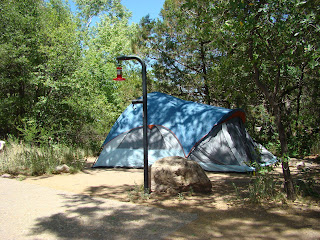
For a much belated honeymoon, Nikki and I decided to take the week before memorial day off and drive out to Southeastern Arizona. This is perhaps the premiere area for a naturalist in the United States, with a high diversity of birds, herps, mammals, insects and plants (not so much if you are an ichthyologist however). This region has been calling to me ever since I first got involved in birding some 20 years ago. Any glance in a birding magazine and you will likely see some mention of this region, calling to birders with its special birds with Mexican affinities, trogons, hummingbirds, owls, warblers! It was something of a dream trip for me, and Nikki was enthusiastic as well because it is perhaps also the best place in the United States to view lizards! So with bags packed and camping gear ready we left Stillwater on May 16th for the long drive towards Portal, Arizona and our first destination the exotic sounding Chiracahua (Cheer-wa-cow-wha) Mountains. Homeland of Geronimo and the other Chiracahua Apache. One look at the above photograph (of the cliffs at the entrance to Cave Creek Canyon) and you may gain an understanding of why the Chiracahua Apache fought so fiercely to protect this land.

We stayed in the Sunnyflat Campground in Cave Creek Canyon, just a short drive from the famous South Fork birding area and only 5 or 6 miles up from Portal. The views from our campsite included the above photo and the following.
Our campsite, the first night camping, was very windy but our tent managed to stay upright, despite us somehow missing one of the tent poles!
So the next morning dawned cold and still windy and I heard very little birdsong, so we decided to sleep a couple of extra hours. Turned out to be a good idea becuase when we started birding at 7:30 it was still cold and there wasn't a lot of bird activity. However we still made our way over to the South Fork of Cave Creek, a place that every birder knows.
At first it was a bit quiet expect for a noisy and curious family group of Mexican Jays.
However after some judicious use of pygmy owl whistling imitations I quickly stirred up a mixed flock of Bridled Titmice, Grace's Warblers, Blue-throated Hummingbirds and this next guy, a beautiful Painted Redstart.
As we moved farther into the canyon, it began to warm up a little and bird activity started to increase as well. Soon we found ourselves sharing the canyon forest with a pair of Arizona Woodpeckers, a particular specialty of Cave Creek Canyon and the Chiracahuas.
This species has recently been split from the Strickland's Woodpecker, a similar species that is restricted now to a small area in the Sierra Madre in Mexico, Arizona Woodpeckers have a deep chocolate brown back and streaking but otherwise kind of resemble Hairy Woodpeckers.
As we ventured farther down the creek bird activity really started picking up, espcially with the warblers, flycatchers and vireos, as we picked up many more Grace's Warbler, Black-throated Gray Warbler, many many Painted Redstarts, Cordilleran Flycatchers, Dusky-capped Flycathers, Greater Pewee (which is a great bird this low in elevation), Hutton's Vireo and Plumbeous Vireo, among others.
However as we entered the Chiracahua Wilderness area the true prize of the South Fork remained quiet and elusive.
I am speaking of course of the Elegant Trogon, the lone regularly seen representive of the trogon family in the United States, a species that arguably draws more birders to southeastern Arizona than any other. And though I had seen many of the other trogon species that occur farther south in Mexico, I still needed to add Trogon elegans to my life list. And if you want to add Elegant Trogon to your ABA area list, the South Fork of Cave Creek Canyon is by far the best place to do it.
Anyway shortly thereafter we heard now 1, not 2 but 3 different Trogons calling across the middle stretches of the canyon. In fact, we had very little difficulty tracking one down where it proved to be quite cooperative, giving us excellent looks and even photography opportunities.
These chunky looking birds have beautiful orangish red breasts and bellies, beautiful dark green heads and backs, a bright orange eye-ring and startingly yellow bill, with a beautiful patterned tail. In short one of the most beautiful birds that grace these United States with its presence.
In Arizona, Trogons occupy some of the most beautiful habitat in the entire region, cool mountain canyons with ample moisture, filled with Arizona Sycamores, Apache Pine and other beautiful and stately trees.
A truly memorable lifer and birding experience and for now I will leave you with a picture basking in the Trogons reflected glory. More on our naturalist adventures to come!




.JPG)
.JPG)


.JPG)
.JPG)
.JPG)
.JPG)

.JPG)

.JPG)
.JPG)
.JPG)
.JPG)
.JPG)
.JPG)
.JPG)






.JPG)
.JPG)
.JPG)
.JPG)
.JPG)
.JPG)
.JPG)
.JPG)


.JPG)
.JPG)
.JPG)
.JPG)
.JPG)
